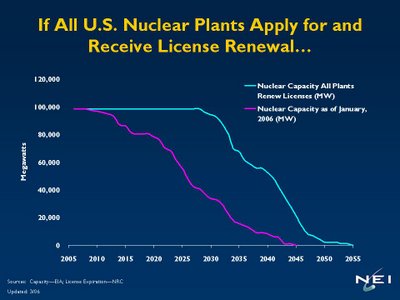 When a nuclear plant retires, the primary source of fuel for its replacement would be coal. A typical 1,000 MW nuclear plant consumes about 20 metric tons of uranium during its fuel cycle (18 or 24 months). A comparable coal plant would need about 3.43 million tons of coal each year to provide the same generation as a nuclear plant. And as we saw earlier this week, transporting large volumes of coal can present other challenges as well.
When a nuclear plant retires, the primary source of fuel for its replacement would be coal. A typical 1,000 MW nuclear plant consumes about 20 metric tons of uranium during its fuel cycle (18 or 24 months). A comparable coal plant would need about 3.43 million tons of coal each year to provide the same generation as a nuclear plant. And as we saw earlier this week, transporting large volumes of coal can present other challenges as well.To replace the same generation with a natural gas plant, you'd need 65.8 billion cubic feet of gas, and for oil, 13.7 million barrels.
If you multiply these figures by 20 years you would need:
68.6 million tons of coal; orThis is for one plant. If a nuclear reactor does not renew its license for another twenty years, the U.S. would need that much more coal or natural gas or oil to meet the same demand. Take these figures and multiply by the 103 nuclear units in the U.S. and you get:
1,316 billion cubic feet of gas; or
274 million barrels of oil
7,065 million tons of coal;The amount of uranium for the additional 20 years needed for the entire nuclear fleet would only be about 41,000 metric tons.
135,548 billion cubic feet of gas;
28,222 million barrels of oil.
And then there's the question of carbon emissions. The average coal plant emits 2,217 pounds of CO2 per megawatt hour. The average oil plant emits 1,819 lbs / MWh and the average natural gas plant emits 1,115 lbs / MWh. The average nuclear reactor generates 7.9 million MWh each year. If a nuke plant were replaced by coal, there would be an additional 7.928 million metric tons of CO2 in the air each year. An oil plant would emit 6.5 million metric tons of CO2 and a natural gas plant would emit 4.0 million metric tons of CO2.
This is only one year and for one unit. I'll let you do the math for the additional twenty years and 103 nuclear reactors.
So the question is this: Would you rather have an additional 41,000 metric tons of used uranium fuel stored safely and securely in dry casks or more than 8,000,000,000 metric tons of CO2 injected into the atmosphere? The next time somebody asks you about the nuclear waste problem, be sure to mention those 8,000,000,000 additional metric tons of CO2.
Technorati tags: Nuclear Energy, Environment, Energy, Technology, Electricity, Natural Gas, Oil, Uranium, Climate Change, Greenhouse Gases
0 comments:
Post a Comment